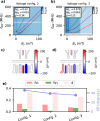Exchange anisotropies in microwave-driven singlet-triplet qubits
- PMID: 40274808
- PMCID: PMC12022185
- DOI: 10.1038/s41467-025-58969-y
Exchange anisotropies in microwave-driven singlet-triplet qubits
Abstract
Hole spin qubits are emerging as the workhorse of semiconducting quantum processors because of their large spin-orbit interaction, enabling fast, low-power, all-electric operations. However, this interaction also causes non-uniformities, resulting in site-dependent qubit energies and anisotropies. Although these anisotropies enable single-spin control, if not properly harnessed, they can hinder scalability. Here, we report on microwave-driven singlet-triplet qubits in planar germanium and use them to investigate spin anisotropies. For in-plane magnetic fields, the spins are largely anisotropic and electrically tunable, allowing access to all transitions and coherence times exceeding 3 μs are extracted. For out-of-plane fields they have an isotropic response. Even in this field direction, where the qubit lifetime is strongly affected by nuclear spins, we find 400 ns coherence times. Our work adds a valuable tool to investigate and harness the spin anisotropies, applicable to two-dimensional devices, facilitating the path towards scalable quantum processors.
© 2025. The Author(s).
Conflict of interest statement
Competing interests: The authors declare no competing interests.
Figures





References
-
- Vandersypen, L. M. K. et al. Interfacing spin qubits in quantum dots and donors-hot, dense, and coherent. npj Quantum Inf.3, 1–10 (2017).
-
- Hendrickx, N. W. et al. A four-qubit germanium quantum processor. Nature591, 580–585 (2021). - PubMed
-
- Wang, C.-A. et al. Operating semiconductor quantum processors with hopping spins. Science385, 447–452 (2024). - PubMed
LinkOut - more resources
Full Text Sources
Miscellaneous

